2015.07.16
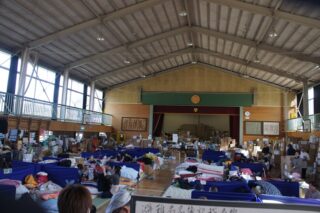
The Great East Japan Earthquake: what happened in a school gymnasium used as an emergency refuge
Preface
As a result of the Great East Japan Earthquake, some 21,000 lives were lost or declared missing. I was affected by this earthquake, and for two months I lived in and helped to manage an emergency refuge located in the gymnasium of Yonezaki Primary School, in the city of Rikuzen-takata, Iwate prefecture.
It was a time of living on the help and support of other people. Allow me first to thank everyone who gave us support.
Normally, it would be enough for me to express my appreciation, along with giving some examples of how the emergency refuge was managed. But for the future reference, I would like to point out some things which can be improved in the management, as well as commenting on some aspects of the support received.
The moment of the earthquake
There are seven of us in my family: my parents, my wife, my son and two daughters. My parents are both from Yonezaki City, and they survived the Valdavia earthquake of 1960. My wife is from Iwate prefecture but from the interior, and until she was married she received no specific education on disaster prevention against a tsunami.
At the time of the earthquake my daughters were in primary school and kindergarten, my year-and-a-half-old son with my wife at home. My father was at the nearby city hall for a meeting. My mother was in bed at home, not feeling well. Earthquakes can happen at any time, and it didn’t wait for a moment when all the family could be together.
11 March, at 14:46 – In the moments before the earthquake, I had departed from Wakinosawa Port in Hirota Bay for my work (oyster farming) and was sailing towards the oyster rafts.
A quake went through the sea, and shook my boat. I fought to control the shaking boat, not knowing what was going on. It was as though I had a rope tangled in the propeller. But the shaking didn’t stop even when the boat moved forward. I shut down the engine, and what came to my ear from my mobile phone was the emergency alarm for an earthquake.
I looked around and saw multiple landslides. I memorized their locations and tried to call 911. The quake didn’t stop. I knew this was real.
Earthquakes originating offshore of Miyagi prefecture had happened before, and it had been said that an earthquake of magnitude 7 could come at any moment. Since the previous Miyagi earthquake (June 1978) it had been 32 years and 9 months, and people living on the coast had acknowledged the accumulation of energy. My instinct told me that a tsunami was to come.
I had only just departed from the shore. I decided to return to port instead of evacuating to somewhere offshore. It took me about five minutes to return, and I tied up my boat and went up onto the land. My five employees were not at the workshop. They were staring at me from the seawall. I asked them if they were OK, and dismissed them for the day, reminding them to avoid traffic on the way. I immediately returned home, too.
Since the moment of the earthquake, I had been worried about my wife and son. In her life she had never encountered a tsunami, meaning she lacked any knowledge of how to react.
Since our wedding, I had told her, “Don’t go back home if there is an earthquake. Go to our uncle’s, up on the hill, and meet me there”, but I wasn’t sure how seriously she had taken my advice, not knowing the reality of a tsunami. I rushed home and found her on the second floor. She said, “We have an appointment at the dermatologist at 4 p.m.” I was right; my words hadn’t got through.
I told her to go get our daughter from school and go to my uncle’s up on the hill, reminding her never to come back home in such a situation. I went to kindergarten to get my second daughter and did the same.
Run! A tsunami is coming!
When I thought the safety of my family was secured, I did something no one should have done. I went back to my neighbourhood, knowing it was where the tsunami could hit.
I was a member of the volunteer fire department, so I was supposed to check up on the elderly, making sure of their evacuation upon the sounding of the tsunami alarm. I went around houses for a good 30 minutes after the earthquake, not knowing when the tsunami might come.
I arrived at one elderly person’s house. I went over to the entrance and found a card which said, “Evacuated already”. I believe that card saved me. Had I not seen it, I would have walked around to make sure no one was there. It was only 50m away from the seawalls, but the seawalls were not visible from her house as it was surrounded by buildings. Now that I think of it, it was a matter of a minute, a second. It could have been too late to escape if there had not been that card.
I checked the neighbourhood, then returned to my house. I went upstairs and looked around. A window was open. My wife probably left it open to avoid being trapped inside. The seawalls were visible from the window. I saw a ship above the seawalls. The tsunami was coming up over the seawalls.
For a moment I couldn’t comprehend it. The next moment I ran downstairs and jumped into my car. Right beside the parking space my father and neighbour were talking. “Run, now! The tsunami is here!” I shouted from the car window.
Later my father told me that he would have been dead if I didn’t shout at that moment. It was that close.
As my father and I arrived at my uncle’s house, we heard someone shout “the tsunami is here!” We were up on the hill, but just in case we ran up to the higher hill behind his house.
When we reached the top, we saw what the tsunami had already swallowed. It was around the tourist district, the pinefield of Takata. The cities of Takata and Yonezaki, the rice fields, the shopping streets, all were covered in black smoke.
Huge aftershocks attacked us repeatedly.
I kept repeating, “It’s ok, it’s ok,” holding my daughters, who were shivering from fear, as though I was trying to convince myself.
I don’t know how long we were there, but the tsunami movement had stopped and the tide was drawing back to the sea. I thought we should go to where everyone else was in order to gather information, and I decided to go downhill towards Yonezaki Junior High School.
Many people had evacuated to Yonezaki Junior High School. It was still light outside. There were probably over 200 people.
A senior member of the volunteer fire department ran up to me and we hugged. “I didn’t see you around and was really worried you could have been taken by the tide. How great to see you!”
From the school yard, I could see where my house, and Wakinosawa Station of the JR Ofunato Line were. That’s right, where they “were”. I saw the condition of the area and knew that my house was gone.
After the earthquake
Right after the earthquake, people began to gather at local cultural centres.
Unfortunately, the tsunami had taken some of the cultural centres. Luckily, some people had evacuated, led by the volunteer fire department, and had come to the school ground of Yonezaki Junior High. Video was filmed during the evacuation by one of the volunteers and can be watched on Youtube anytime.
Students were waiting for their family to pick them up. Some went home with parents, and those whose family didn’t come joined the evacuated group of people and, under the school principal’s command, we acquired water and started cooking.
Students took out some pots and pans from the school for cooking. Adults went around the neighbourhood asking for some rice or water. Dry pieces of wood were collected, rice was cooked, rice balls were served for kids and seniors first. There was not enough rice, and adults shared some burned rice from the pots and tried to overcome hunger.
March in Iwate is winter. It was shivering cold in the gymnasium. Blankets were borrowed from neighbours, and we sat close to one another, putting arms around knees, spreading blankets around. Aftershocks repeated in the middle of the night, but we escaped to some higher hills using flashlight from mobile phones.
When the morning came, we realized that the gymnasium and the main buildings of the school had cracks in the walls. The school principal judged it too dangerous for people to stay, and apologized.
A few people checked around the area and confirmed that the Yonezaki Primary School gymnasium was not in use, so we all moved. With the principal’s permission, we brought with us mattresses for gym, tatami for judo, and heating stoves (with gas; no electricity required).
This is how our long days of refuge began in the Yonezaki Primary School gymnasium.
Early days in the gymnasium of Yonezaki Primary School, the emergency refuge (4 days)
On March 12th, there were probably over 200 people who moved from the junior high. We were in shelter but we lived with shoes on, so that we could evacuate from any exit if needed.
The first thing we checked upon moving was the water and bathrooms. The gymnasium bathrooms were connected to a septic tank for combined treatment of wastewater, and it could have broken down had we flushed toilets without electricity.
When we contacted a local plumber, he told us to flush with water, and that he’d check on us regularly. We decided to keep water in buckets and use it only in cases of defecation. We took turns to bring in water from the river to use in the toilets.
On the other hand, we couldn’t provide drinking water from the river. I searched and found two spring-water fountains which were about five minutes away by car. The owners of these lands connected hoses to the fountains. We were able to borrow 500 litre tanks from local apple farmers for carrying water. We put these tanks on a pick-up truck, and took turns twice a day to obtain water for drinking and cooking.
The next task was to secure our food supply. There was a kitchen in the school, but the gas was connected behind walls which were cracked after the earthquake. The gas alarm wouldn’t have worked either, due to the lack of electricity, so we could not use the kitchen.
Fortunately, there was a kindergarten about 100m away that had a kitchen. It was an old building, but because of that the pipework was external and rubber hoses were used for connections. We mixed water with detergent to check for any leakage. We were able to start cooking from March 12th.
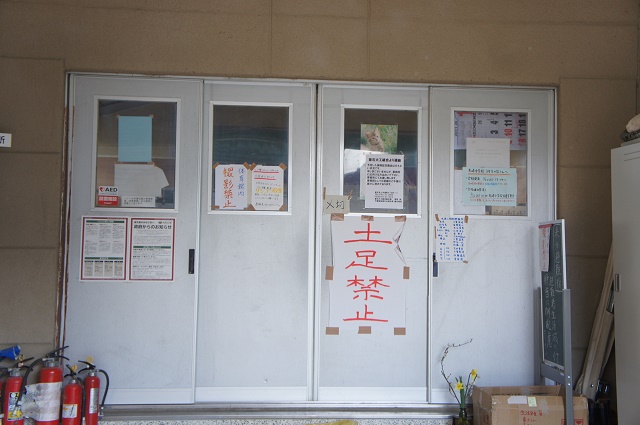
By the third day after the earthquake, water, rice, vegetables and blankets started arriving from individuals. Construction workers nearby brought us a big generator. Neighbours who had two rice cookers would lend us one. With a generator and rice cookers, we could cook rice, but there were only six rice cookers, each with a maximum capacity of five cups of rice, for 200 people. Even at maximum usage, by the time everyone received rice it was time for the next meal.
In the afternoon, a sushi restaurant from Ofunato delivered us sushi, because the stock would have otherwise spoiled due to lack of electricity. The local delicacy “Eggs of Seagulls” (sweet pastries) were brought, too. Sushi and sweets; it was more than luxury under the given circumstances. We enjoyed it with tears in our eyes.
On the fourth day, the first group of the Self Defence Army came to inquire about us. We were told to keep half the school yard empty for them to start activity as soon as they arrived. The Self Defence Army immediately set up facilities for bathing, cooking rice, and laundry. It took three more days for the bathing facility to function, but rice was immediately cooked.
We were all able to eat hot rice balls together, even those who were cooking. It was a moment of true happiness. We started to fancy miso soup and entrées.
In those four days, every refugee voluntarily cleaned, cooked, organized supplies, mended, or attended visitors. And as time passed, natural leaders emerged who arranged matters. I was in charge of general correspondence, so I picked management committee members individually according to their fields of expertise.
The Management Committee
We selected the following people to take charge of the Yonezaki Primary School emergency refuge:
General Leader: the main duty was to liaise with aid-providers, so this person had to be able to stay in the refuge 24 hours a day.
Sub Leader: An assistant, selected by the general leader.
PR: We selected a person who had contacts within local sports clubs and cultural centres.
Medical: There were three former nurses in the refuge, so one of them was selected.
Chef: We searched for someone who had experience in cooking for large numbers of people, but as there were not any we selected a nurse who was an expert in the prevention of lifestyle diseases.
Maintenance: We selected a carpenter, whose duty was to maintain the facilities.
Administrator: Duties included recording and releasing the meeting minutes, managing borrowed machinery, fuel, materials etc. I took the position.
We also asked other volunteers to man the reception, gather supplies, or compile orders of materials. Of course, all the refugees worked hard, not only the committee members. We started with installing more shoe shelves at the entrance, and by the end of our days in the refuge we had set up a kitchen next to the gymnasium.
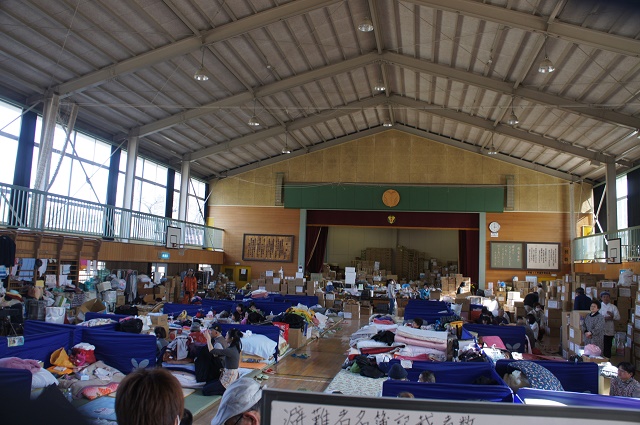
What we intended in management
Here I would like to note what we intended to achieve by managing the refuge.
1. Supplies to be visible
In order for everyone to know if “there are” or “there isn’t any”, all the supplies were placed where everyone could see.
2. Committee members never take supplies first
In order to insure people’s cooperation with the things the committee decided, members should not behave for his/her own benefit. Therefore, we passed a resolution that members do not take supplies first, and announced this. No matter how great the ideas or decisions were, no one would listen if they thought members benefitted from those decisions.
3. Explanation of decisions are given when everyone was present
Most refugees had lost houses and/or family members, and they all went to clean up or search during the day. Distributing supplies as they arrived would have caused unfairness among the refugees. Therefore, all the materials were piled up on the stage or interior balconies. Supplies were divided by categories and distributed every day at a certain hour in the afternoon. As a result, refugees could have free time, except cooking or cleaning hours.
4. No hierarchy caused by possessions
First, we collected mobile chargers from everyone, and the administration charged everyone’s phone. We were able to gather all types of chargers for different carriers. (Back then chargers were not compatible among different carriers.) If people were forced to borrow things among themselves individually, that could have caused “stronger” and “weaker”, which we tried to avoid.
Attending those in needs
<Elderlies>
In Yonezaki refuge, there was no one who wandered around, but there were those who needed assistance in going up the staircases. Also at night, there were those who couldn’t find their families’ sleeping areas.
<Handicapped>
Adhering to the principle that everyone should have a duty, one handicapped male was given charge of distributing beverages. Refugees tend to minimize water consumption in order to avoid using bathrooms. So his task was to remind everyone to drink and hand out tea, water, or sports drinks from relief supplies.
<Infants>
My son was only a year and a half old when the earthquake occurred, and I personally experienced the difficulty of having an infant in a refuge. As someone has to look after the child all the time, it was stressful not to be able to join and help the work everyone else was doing.
During the transition period from milk to food, baby food has to be provided. The cry of a baby is stressful for mothers, as well as for those who don’t have kids.
Hence, we rented a room from the school and gathered households with infants, so they could help each other. Households with infants don’t mind babies crying, and they could share powdered milk or diapers.
Both powdered milk and diapers were provided via aid, so they belonged to no one, and all were shared according to size or age. Unlike in the gymnasium, where there were sighs and agitation, the children’s room was where angels played. When I got tired, I used to go to the kid’s room to be healed by their voices.
Difficulties
<Coldness>
It was still winter on March 11th in Rikuzen-takata. The school gymnasium had a really high ceiling, and heat rose upwards without warming the surroundings. I remember people could not sleep at night due to lack of blankets for half a month or so.
<Pain>
One of the difficulties in the refuge was pain. There were those who had severe headaches caused by high blood pressure because of stress. Another problem was toothache. In cases of severe headaches we could call an ambulance, but we couldn’t do so for toothache, and there was no information available regarding which dentists were accepting patients. We recognised the importance of regular check-ups.
<Lack of space>
One of the top problems at refuges is lack of space and privacy. With the exception of families with infants, everyone slept in the gymnasium and had a space of 250cm x 80cm. Beside pillows (or feet) there was a small space to put a change of clothes or drinks, but that was it.
<Pets>
No small number of people considered their pets as family members, but having pets in the gymnasium could result in many different kinds of trouble. We kindly asked them to keep their pets in their cars or other places.
<Mistaken with municipality>
The municipality of Rikuzen-takata was swallowed by the tsunami up to the top floor, and many of its workers went missing. Civil servants are also civilians, meaning they are also victims. However, the municipality had to function for normal duties, the earthquake response as well as confirmation of missing ones, and there was no person to send from the municipality to be in charge of running the refuges.
Under such circumstances, people who sought information or help came to the school gymnasium. They were looking for their family members, relief supplies, or some of them complained to us about when the Self Defence Army would come or how the municipality was handling the situation.
There were only refugees and no civil workers, nor anyone who had the time and the strength to contact the municipality for those people, so we politely declined.
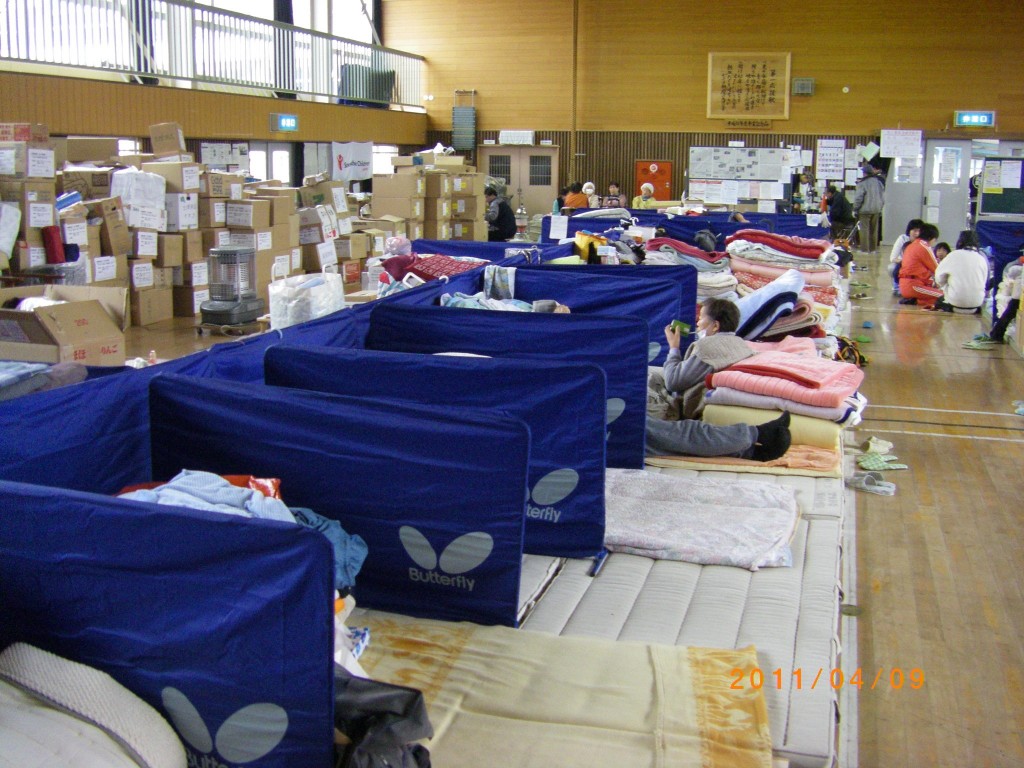
About Meals
Right after our life in the refuge started, we had no idea how long we could expect to wait for food aid to arrive, so we tried not to use ingredients which could last a long time without perishing. As a result, the contents of meals were unbalanced.
What we feared in communal life was food poisoning, so we avoided raw food, and fried meat. Leaf vegetables were limited and couldn’t last long, so we used them whenever we had them. However, vegetables were not delivered every day. There were, naturally, periods when we didn’t have vegetables for the whole week.
After two weeks had passed, there was enough food stored, so we started eating fish from cans, and the elderlies were especially happy.
It was difficult to choose which food supply to use. There were many of us. We didn’t know how long aid would last. We had large amounts of cup noodles stored but,if consumed by 200 people, they would immediately disappear.
And because there were many of us, it took a long time to cook. It required at least two hours to cook and serve each meal. There was no fridge, so on hot days dishes would go bad before served, so we ate cup noodles during the day.
Yet another problem was allergies. There was a family who had a child with a gluten allergy. In the early days in the refuge, we had no food to comply with his requirements. People around him started eating some dishes while he could only eat rice balls. We felt very guilty about it but there was nothing we could do. After a few days they moved to their relative’s house.
We received various aid concerning meals, so I would like to present some of them.
<Food aid>
Food was delivered to support us, so I know this sounds rude, but necessary items didn’t arrive at the ideal time and in the ideal amount.
We received a lot of cup noodles, as they could be stored for a long time, but in reality, it was not easy to boil water for 200 people.
One of our concerns was the lack of seasonings. It is not healthy to eat very salty food, but food with no salt is really not appetizing. At any rate, it was food for 200 people, so the amount of salt, sugar, soy sauce, vinegar, or miso required was the same as in any canteen. With limited seasonings, the choices of dishes that could be cooked was also limited.
<Soup kitchen that never arrived>
When volunteers contacted us offering a soup kitchen, we agreed a schedule with them.
However, there were several instances when they didn’t arrive. We could have reacted if at least they had informed us that they were not coming, but there was no way to contact them. We only got mobile phone reception back over a month after the earthquake.
We were not informed which route they would take or where they were going prior to our refuge, so we couldn’t even go to check up on them. After waiting long hours, we judged they wouldn’t come, and had to ask mothers, who had anticipated their day off, to cook something quick. This happened more than just a few times.
Some days later, when we contacted them, we were told that more people had appeared in its neighbourhood, and they had no supply nor time to come over to our refuge.
<Soup kitchen which was troublesome>
One day, we had a group of volunteers who served us great food; very tasty and a generous amount, and we all felt very fortunate and full for the first time in a long while.
However, something was wrong. They didn’t seem to have brought so much food with them when they arrived We realized that all our food supplies, such as leaf vegetables and potatoes, which were already prepared for the next day, were gone. The canned food for the following days was gone, too. They used up all our stocks!
We could barely manage to make the daily meals, calculating the amount of food supplies left and planning two to three days in advance. Our staff were highly discouraged to get back on track. On top of that, rare seasonings were also used up.
Even though the soup kitchen was an act of good will, one of our members couldn’t help but to shout that they should never come back.
Supporters came and emptied our stock of foodstuffs and seasonings, and our plans were forced to change. The shortage of food supplies caused huge disappointment among the cooking group. We had several days of soup with nothing in it, and tasteless dishes.
Aid that helped us, and not so much
We were very grateful for every piece of aid we received. However, our needs changed as time passed by.
In the early days in the refuge, blankets, food, water, cloths, medicine, female sanitary supplies, and heating which required no electricity were needed.
After a few days, we needed materials concerning long-term shelter. Rice, canned food, medical masks, pillows, loose clothes (for sleeping), plastic sheeting, for example.
After a few more days, shoes (like sneakers), wellingtons (for searching after the tsunami), materials to divide sleeping spaces in the gymnasium, food with a stronger taste, sweets, were wanted to accentuate everyday life.
Among what we received, there were unexpected relief supplies.
Those who survived through the Kobe and Nigata earthquakes delivered us business card holders, notebooks and pens, markers, large drawing papers, and computers. In the early days we just struggled to survive, but those materials helped us greatly to record or announce management of the refuge. Coffee, beer, cigarettes, TV, comic books, etc were such a luxury that we could not have possibly requested them, but it was great to receive them.
<What aid do you need?>
Upon receiving support, the most problematic question was, “What do you need?” The answer could only be, “We need everything. Everything you need in your life, we don’t have.”
Each organization has a field in which they are skilled, and not so skilled. It is only natural that a student organization, which has time and manpower but no money, and a CSR (corporate social responsibility) organization differ in what they can provide. If we knew what area the organization was good in, it was easier for us to make a specific request.
For example, the Refugee Support Association, having experience in supporting people in need on a regular basis, came to affected areas immediately to make inquiries. They brought numerous experts in law and finance, as well as in women-specific matters, to engage in resolving issues.
Also, Save the Children Japan came to the Yonezaki Primary School refuge about 10 days after the earthquake, and provided us with materials and volunteers for the children to play with. There were many refuges in the affected areas and one organization could not look after all those places, so children’s support organizations contacted each other and coordinated, as I found out in later days.
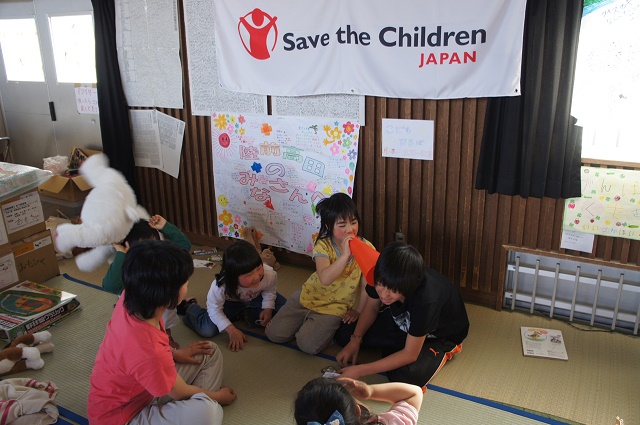
Other support included sports instructors. They were concerned about refugees, who lack exercise when living in limited spaces and get sick, so they came on a regular basis over a long period to instruct us on exercise. I recall it was easy to cooperate with organizations which had a clear aim in their activities.
We received so many kinds of support, but among them there were some slightly “troublesome” ones.
<Distribution of relief supplies with no attendant>
Once a big truck came full of clothes from a clothing company. Over the whole city leaflets had been scattered, saying, “There will be distribution of clothes in front of Yonezaki Primary School.”
On that day, by the time the truck had arrived and unloaded the supplies, there was a long queue of people. But there was no one in charge. No one said to start, nor informed how many items of clothing per person were provided.
The first person in the queue was about to take some cloths, but people behind became very anxious. “How many pieces per person?!” “What time does it start!?” People started shouting. There were some who jumped the queue and the crowding worsened. Though this clothing was not delivered to our gymnasium refuge, we decided to take care of the distribution. “What were you doing!?” “Hurry up!” “We can’t hear you!” The crowd was in uproar.
On the TV and in newspapers, it seems to have been reported that the refugees were well organized, even in time of chaos. That was only the case where there was good management. In other places, once people panicked, it took a lot of effort and time to calm them down.
<Support which violated privacy>
The Active Listening volunteers (non-professionals) caused compliance issues. They came to our refuge and to other temporary housing, where they would volunteer to “provide conversation”.
Unfortunately, they would listen to one family, and then tell that family’s whole story to the next family. In the worst cases, they published those stories in their activity reports. Very personal information, such as the panic at the moment of losing family and friends or financial trouble relating to inheritance, was reported in detail. Names were not stated, but we knew whose stories they were. And it was all open to the public.
We demanded an immediate suspension of publication, and asked why they would do such a thing. The answer was: because their activities were funded, and detailed reports were required.
People who told their private stories didn’t think the information would be leaked. Furthermore, they couldn’t have imagined that people at the same refuge would find out all about it. I strongly wished that whoever coordinated Active Listening would have educated their volunteers before their activities started on what they could or could not tell others.
Lastly – who engages in disaster risk reduction?
Prior to the Great East Japan Earthquake, the expression “disaster prevention” was commonly used. However, after that, the more widely used term is “disaster risk reduction”.
What is the difference between disaster prevention and disaster risk reduction?
“Disaster prevention” aims to protect lives and properties. “Disaster risk reduction” hopes to protect lives by temporarily giving up on protecting properties.
During the Great East Japan Earthquake, there were many people who evacuated initially, but then went home for wallets or a Buddhist mortuary tablet, and never returned.
First of all, we have to be aware of the fact that our home is not an absolutely safe place. Homes can provide privacy and we have everything we need there, but the ground on which they stand may not be safe. Around cliffs, rivers, or seas, please find out where your house stands, and where the closest evacuation facilities are.
Next, please get rid of ideas that our government or the Self Defence Army will take care of you in cases of disaster. They can’t really do anything. In the case of an earthquake, the Self Defence Army will not prevent your furniture from falling onto you.
Lastly, acquire knowledge on weather lore, fix-down furniture, and pay close attention to information on emergency alarms. Weather lore may sound complicated, but when the sky turns dark all of a sudden, anyone would run into shelter or places with roofs. That is the basics of weather lore. Weather lore starts from the moment when you look up at the sky with your family and say, “It seems like it’ll rain, let’s check the weather forecast”.
The Great East Japan Earthquake was predicted under the name of “Miyagi offshore earthquake”. So were the epicentral earthquake, Tokai, Tonankai, and Nankai Trough. They are all predicted to come.
In the case of an earthquake, please never abandon the option to escape. Instead of thinking, “It’s pointless to run away because a 20m high tsunami might come”, escape even just a little bit. The tsunami may only be two metres high.
After the Great East Japan Earthquake, especially among the elderly, I often hear phrases like, “I’m old, so I won’t escape next time.” I would really like them to remember those members of the volunteer fire department, or their neighbours, who risked their own lives in helping those who were too weak to run. Your option of not running away may endanger the lives of others.
Disaster risk reduction can make a great contribution when government, local communities, and individuals are all engaged. I want people to realize that the idea of “someone will help us” will expose your family or loved ones to danger.
This is a sincere request from a person who has lost very important friends in the Great East Japan Earthquake.
元記事:佐藤一男 東日本大震災、体育館避難所で起きたこと (Translated by: Sadami Harada)
プロフィール
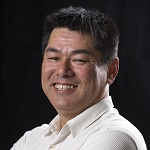
佐藤一男
米崎小学校体育館避難所元運営役員。米崎小学校仮設住宅自治会長桜。ライン311 元副代表http://satokazuo.com/index.html


